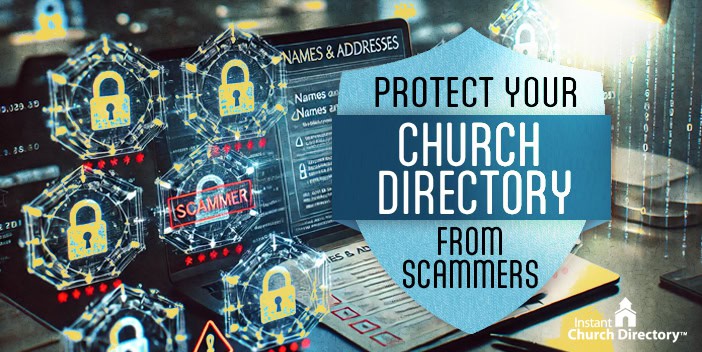Church directories build community and enhance communication, helping congregants stay in touch and support one another. But because directories are filled with personal information, they can be targets for scammers looking to exploit people’s trust.
Digital directories, thanks to their convenience and accessibility, are more popular than ever. That also means pastors and church administrators must stay alert to threats such as fraud. Protecting the privacy of church members and the integrity of your directory are key.
The first step is staying informed about the latest scams. By using deceptive tactics, scammers try to gain access to the online directory. They may send an email, asking to join your church directory even though they have no connection to the congregation. Once they’re in, they can infiltrate the listings and use contact information to run email scams. Common scams involve impersonating the pastor or another religious leader to request gift cards or cash.
Protecting Church Directories From Scammers
Read on to learn more about scammers wanting to join church directories. Discover how to prevent and stay vigilant against directory scams.
How This Scam Works

To infiltrate church membership directories, bad actors use false pretenses. Their goal is to obtain sensitive information such as names, phone numbers, email addresses, and home addresses. Once they have that, they can attempt identity theft, a phishing scam, and financial scams targeting vulnerable parishioners.
One common tactic is claiming to be new to the church or community and wanting to connect with fellow Christians. Scammers may offer a fake story about their faith journey in Jesus Christ or express interest in becoming more involved in church activities. By appearing friendly, a scammer aims to lower suspicions.
Scammers also might pose as representatives of other churches or organizations you’re familiar with, making requests seem real. Or, to gain trust, they might drop the name of a current church member or church leader, claiming to have been referred by them.
How to Identify Scammers
The goal is to spot a scam before someone gains unauthorized access to your online directory. Because scammers often create a legitimate-looking email address, such as through Gmail, it’s important to vet carefully before adding anyone. Otherwise, they can exploit people via texts or an email scam, such as asking for a gift card or donation.
Watch for these red flags when evaluating new members or directory applicants:

- No real connection to the church — If the individual has no visible ties to your congregation — no one knows them or they haven’t attended or participated — investigate further. Scammers often target churches where they have no established relationship.
- Incomplete or vague information — Scammers might provide incomplete information to the church office. Or they might be vague about their personal details or connection to the church. If someone seems evasive when you ask basic questions, that’s a warning sign.
- Overeagerness to access the directory — Be cautious of persistent individuals who want in the directory. Legitimate new members typically want to form bonds before seeking access to parishioner information.
- Suspicious online presence — Conduct a quick online search of directory applicants. If they have little to no online footprint or their social media profiles seem suspicious (few friends or posts), they might not be who they claim to be.
- Unusual communication — If someone attempts directory or newsletter signup via unsolicited emails, calls, or other unconventional methods, use caution. That’s how some scam artists bypass the normal vetting process.
How to Verify New Church Members
These days, pastors or administrators must vet and verify before adding people to a church directory. Instead of being worldly, that shows you’re responsible and care about people’s well-being. Use these steps to double-check before including someone:
- Meet in person. When possible, meet potential new members before granting directory access. Then clergy can get to know them and verify that they belong.
- Check references. If someone claims that a current member referred them, take time to verify that. Reach out to confirm that the individual is known and trusted.
- Set guidelines. Require people to attend a certain number of services or church functions before being added to the directory. This ensures they’re genuinely invested in the faith community.
- Have a formal membership process. Consider using an application, interview, and possibly a background check. This may deter scammers from attempting to join your church.
How to Protect Your Church’s Online Directory
Security measures can prevent scammers from obtaining personal information. Protect members’ privacy with these consumer protection tips.
- Password-protected access — Keep your directory password-protected, limiting access only to current members. Avoid generic or easily guessable passwords and update them often.
- Roster review — Periodically check the list of who can get inside the church directory. Ensuring that everyone is a current, active member minimizes the risk of unauthorized access.
- Tiered access — Not all directory information should be accessible to everyone. Create tiers so only trusted leaders or church staff can see certain data.
- Regular training — Educate church administrators and volunteers about scammers’ tactics and how to recognize a fraudulent email.
- Secure platforms — Use a reputable online or digital directory service. Review the provider’s security features, such as encryption and user authentication to avoid hackers and scammers.
What to Do If You Encounter a Scammer
If you suspect someone’s trying to access your church directory under false pretenses, act quickly. Follow these steps:
- Reject the request. Politely but firmly decline. Explain that the church has strict security measures to protect members’ privacy.
- Notify church leadership. Immediately report any suspicious activity to church leaders. When the team is aware of threats, they can monitor for scam attempts.
- Notify church members. Be transparent about what occurred. Also inform congregants about steps you’re taking to avoid further directory breaches.

- Report the scam. If a scammer targets your church or gains access, contact law enforcement. Consider notifying other local churches so they can be on alert. You may also want to contact an official government organization or the Better Business Bureau.
- Review directory security. After a scam attempt, review your safety measures to eliminate any vulnerabilities. Update passwords, remove inactive members, and tighten access controls.
As scammers become more creative and sophisticated, churches must proactively safeguard directories and members. With careful vetting, regular training, and solid security, you can reduce the risks.
Encourage your congregation to remain vigilant and to report any suspicious activity promptly. With precautions in place, your church directory can remain a safe, trusted resource for your faith community.
